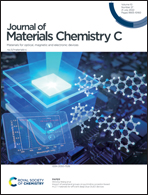Controlling the device functionality by solvent engineering, solar cell versus light emitting diode†
Abstract
In this work we studied inverted perovskite device structure which can function as a solar cell and as a light emitting diode (LED) simultaneously. We found that changing the solvent ratio, Dimethyl sulfoxide (DMSO) to Dimethyl formamide (DMF) in the perovskite solution has a dramatic effect on the device functionality. It was observed that the solvent ratio significantly affects the perovskite layer leading to opposite optimization functionality. In the case of only DMF the devices function efficiently as an LED with a preferability for radiative recombination as was measured by photoluminescence lifetime and electroluminescence (EL) demonstrating external quantum efficiency (EQE) of 10.8%. When adding DMSO to the perovskite solution the device showed an increase in the efficiency as a solar cell and a reduction in its EL with a power conversion efficiency of 14.4%. This is mainly due to adjustment in the thickness and uniformity of the perovskite layer with less PbI2 residues (as a result of the addition of the DMSO) measured by X-ray diffraction. This work demonstrates the ability to control the device functionality between solar cell and LED by the solvent ratio in the perovskite's precursor solution.



 Please wait while we load your content...
Please wait while we load your content...